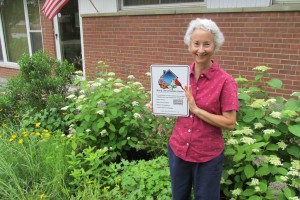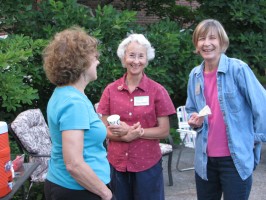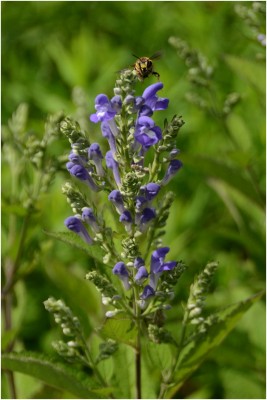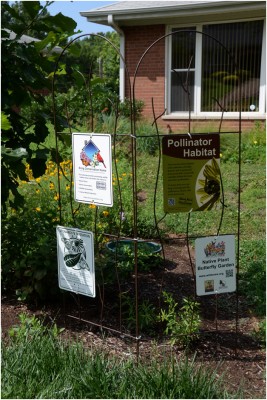By Peggy Whetzel
 Small though it is, Fran Glass’s yard could serve as the poster child for making the world a better place, one suburban yard at a time.
Small though it is, Fran Glass’s yard could serve as the poster child for making the world a better place, one suburban yard at a time.
There are no roses, daylilies or beguiling begonias. Instead, with a gardener’s guiding touch, she’s sprouted a landscape brimming with 170 wild or native species ranging in size from a mighty bur oak in the back yard to a ground-hugging party of pussytoes (Antennaria) in the front.
Once common to Missouri, these and thousands more species have been steadily supplanted by ornamental trees, shrubs, vines, flowers and grasses from Europe and Asia. In the process, birds and insect populations have dwindled and even disappeared.
That’s because, with rare exceptions, North American insects cannot digest ornamental plants from other continents, plants they didn’t evolve with. Just because something is green doesn’t mean it’s universally edible. Most caterpillars can only eat certain plants. Monarch caterpillars, much in the news this year, can only eat milkweeds. Nothing else will do.
In her yard at least, Fran is taking the old neighborhood back. And it’s working.
“I’ve seen the changes since using native plants,” she said. “The diversity and number of pollinators is just incredible.”
With native plants growing in place of non-native lawn grasses like fescue (which is from Europe, and no more edible than green cement to local insects), Fran’s yard has awesome curb appeal to butterflies, bees, birds.
Although she feeds them only during winter (though water is provided year-round), there are always birds to be seen in Fran’s garden. That’s because the rest of the year, “There’s plenty for them to eat in the yard.”
With only native wildflowers to attract them, for example, hummingbirds are a staple of her summer garden, sipping nectar from blue sage and royal catchfly. In previous years, “We put feeders out, but saw no hummingbirds,” she said.
On a recent fall morning in Fran’s front yard, pretty skippers (small relatives of butterflies), and several varieties of bees breakfasted on the daisy-like blooms of aromatic asters. In the back yard, Fran pointed out a newly-discovered bird’s nest tucked into a native Dutchman’s pipevine (Aristolochia tomentosa) twining up a trellis. The nest was revealed after the vine’s heart-shaped leaves dropped as fall came on.
In winter, she enjoys watching birds searching out seeds and overwintering insects. “I love to leave all the stalks over winter because the birds use them for food and shelter, and it’s such an interesting habitat structure,” she said.
With such a big garden, does she spend much time weeding?
“Not anymore,” she said. When she first planted her beds, a fair amount of work was needed to keep weeds in check. “But as the plants self-seeded and the garden got fuller, there were fewer weeds.”
Fran has designed her yard so that it looks welcoming to people as well as wildlife. In the front yard, native perennials selected to grow about three feet or less set off the brick house where she’s lived for 38 years. Taller plants, such as elderberry, cup plant (Silphium) and New England aster thrive in her back yard prairie garden.
In response, her neighbors have expressed appreciation for the wildflowers and birds. And passersby take the time to check out the natural landscaping awards which are posted at the front of her garden by way of an introduction. Among them: her yard is certified platinum by the St. Louis Audubon Society’s Bring Conservation Home program.
“No one asks me to mow,” she said.
Fran gladly shares her tips for planting native gardens geared to universal curb appeal:
- Start small, so that the garden is manageable.
- Choose plants that are adapted to the site and that you are attracted to.
- In the front yard especially, make sure everything is tastefully done, that it looks intentional, and it’s very attractive at all seasons.
- Mow paths through the garden.
- Maintain distinct beds.
- And don’t have overly-tall grass.
Fran highly recommends enrolling in Native Plant School at Shaw Nature Reserve to learn how to garden with natives.
 And perhaps most important, come to Wild Ones meetings as a guest or become a member. Meetings are usually held at a site with native gardens. “That’s the best thing about Wild Ones, getting to see other people’s yards, sharing ideas and learning from them,” she said.
And perhaps most important, come to Wild Ones meetings as a guest or become a member. Meetings are usually held at a site with native gardens. “That’s the best thing about Wild Ones, getting to see other people’s yards, sharing ideas and learning from them,” she said.
For Fran, advocating for nature has led to lifelong friendships. Shortly after college, she met people who “shared the same environmental values, taking care of native landscapes, our forests and rivers, and treading lightly on the earth,” she said. “Nature is so important to me, and I see too much destruction going on.”
She joined the Ozark Chapter of the Sierra Club (now the Missouri Chapter) where she worked on committees with several people who are now (also) Wild Ones members, including Ed Schmidt. Sixteen years ago, Scott Woodbury, current curator of the Whitmire Wildflower Garden at Shaw Nature Reserve, founded the St. Louis Chapter of Wild Ones, of which Fran is a charter member. For the past seven years, she’s served as the group’s secretary.
The group welcomes and would very much like to have more people volunteering to serve on the board, chairing committees and helping with projects. “It’s very rewarding and everyone is so helpful to one another,” she said.




Peggy
Thanks for writing such a nice article about Fran. You covered her as well as our cause.
Kathy
Thanks, Kathy, it was my pleasure. Fran is wonderful company, too.